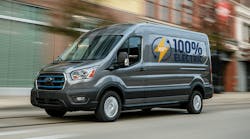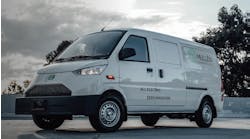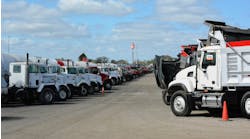Ford on Tuesday opened its website for “hand-raisers” to register their interest in learning more about the E-Transit, the company’s first-ever full-size all-electric van, ahead of order banks opening by July.
Along with the registration site, E-Transit has updated pricing, with a targeted starting MSRP of $43,295 for the cutaway—lower than originally announced—to $52,690 for the high-roof extended-wheelbase cargo van, Ford notes.
To date, more than 450 commercial customers in North America, including 200 top fleets and fleet management companies, have said they’re interested in purchasing the all-new E-Transit.
Demand for all-electric vans is growing. Ford data shows that in the U.S., 70% of the full-size bus and van business is going all-electric by 2030—that represents more than 300,000 vehicles annually and a significant opportunity the country’s leading commercial van brand.
The vehicle offers eight configurations, including cargo van with three roof heights and three lengths, plus chassis cab and cutaway models, lending itself to a wide array of applications. Preliminary conversations with commercial customers indicate a healthy mix for demand across all eight configurations, with roughly 40% leaning toward high-roof vans and 60% pointing to medium-roof, low-roof, cutaway and chassis cab versions, according to Ford.
“We’ve had so much interest early on, we wanted to open this registration site to serve customers with a build mix for their needs across all van body styles,” said Ted Cannis, general manager, North American commercial business. “Some customers want high-roof vans to maximize internal cargo space, while others need to install bodies on cutaways and chassis cabs. Customers will have an all-electric solution—from box truck delivery to parking structure-friendly utility service vans and everything in between.”
Internal data shows early order indicators favor the delivery segment—ranging from wholesale goods to packages, groceries to replacement parts—with many other vocations in the hand-raisers group looking to take advantage of E-Transit versatility, Ford reports. These include equipment rental; local, state and federal government agencies; utility services; and telecommunications. Customers also have shared plans to use E-Transit for recreational vehicles, school buses, automotive service, carpet cleaning, service vans and other commercial applications. More unusual applications offered include armored transport, blood donation units and prisoner transport.
Customers can sign up at the new E-Transit registration site on Fleet.Ford.com to review the targeted starting MSRP and targeted driving range for all configurations for E-Transit cargo van. Customers can also indicate their desired versions and receive the latest news on E-Transit, including notification when order banks open. No deposit or purchase commitment is required.
“Customers should be thrilled to see that the starting price is well under what we announced at the E-Transit reveal in November,” said Cannis. “We want to make these products accessible and turnkey because, as the trusted leader we are today, we know customers need electric products that fit their business—not the other way around. And E-Transit can further help save on operating costs compared to gas-only vans.”
The zero-emission E-Transit was designed with insight from 30 million miles of customer telematics data showing that the average commercial van drives 74 miles per day, Ford notes. With a usable battery capacity of 67 kilowatt-hours, the low-roof E-Transit cargo van has a targeted driving range of 126 miles.
Available Pro Power Onboard turns E-Transit into a mobile generator with up to 2.4 kilowatts of available power to help customers use and recharge job site tools ranging from belt sanders to miter saws. When paired with an activated standard embedded modem, standard SYNC 4 brings connected solutions that unlock software subscriptions to help fleets manage charging transactions, telematics services and more.
E-Transit offers the same cargo dimensions and standard mounting points as the gas-powered van so fleets can continue to use the same upfits, racks, bins and accessories they have now while taking advantage of the improvements in uptime and productivity provided by the fully electric powertrain, new software solutions and Pro Power Onboard options.
Potential savings are expected from day one, as scheduled maintenance costs over eight years/100,000 miles are projected to be 40% less than for the gas-powered Transit based on recommended service schedules published in 2019 and 2020 owner’s manuals. E-Transit is backed by 645 Ford Commercial Vehicle Center dealers across the U.S.—about 90% of which are electric vehicle-certified, according to the company.
This summer Ford rolls out a pilot program in which key customers test the electric van across a variety of vocational use cases. More information about the pilot will be available at a later date.
E-Transit, the first all-electric cargo van from a full-line automaker in North America, is part of Ford’s more than $22 billion investment in electrification through 2025. The all-new, all-electric Mustang Mach-E is on sale now, E-Transit is available later this year, and the all-electric F-150 hits dealerships in 2022.
This article originally appeared on Trailer/Body Builders.





